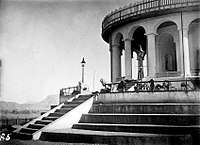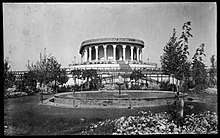Chihil Sutun
For the pavilion in Iran, see Chehel Sotoun
_(NO-NB_BLDSA_GM2a307n).jpg)


Chihil Sutun (Persian: چهلستون, meaning "Forty Columns"), also spelled Chehel Sutoon or Chelsutoon, is an area in southern Kabul, Afghanistan, part of District 7. It is named after the Chihil Sutun Palace, a garden and pavilion that was built by then-Emir Abdur Rahman Khan at the end of the 19th century in the area. Historic maps also refer to both the palace and area as Hendaki.[1]
The palace's commemorative plaque was set in 1888. It was expanded with paved walkways and marble fountains by his successor Habibullah Khan. It had been used at times as a state guesthouse during the 20th century, notably being the visiting residence of Dwight Eisenhower and Nikita Khrushchev, and during the communist era was used as a government media hub. The site was heavily damaged by civil war and remains unused to this day.[2]
Today the area is located in the outskirts of the city's urban area, just east from the Kabul River that streams south towards Char Asiab. The Chihil Sutun Road links it towards central Kabul to the north and Darulaman to the west. Like other places of District 7, it is an unplanned area and generally poor.[3]
References
- ↑ electricpulp.com. "ČEHEL SOTŪN, KABUL – Encyclopaedia Iranica". www.iranicaonline.org.
- ↑ "Chihil Sutun Palace - Archnet". archnet.org.
- ↑ Community Scorecard of Kabul Municipality 2016 Integrity Watch Afghanistan